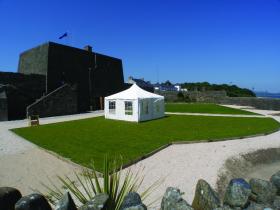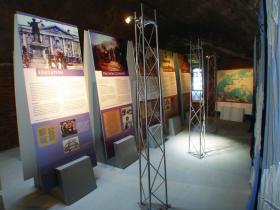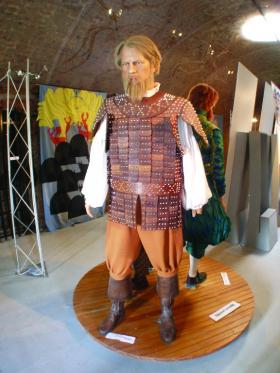Museum Eye: Flight of the Earls/Rathmullan Heritage Centre
Published in Early Modern History (1500–1700), Issue 4 (Jul/Aug 2007), Reviews, Uncategorized, Volume 15
The centre is housed in an old gun battery on Lough Swilly.
The centre is housed in an old gun battery on Lough Swilly.Flight of the Earls/Rathmullan Heritage Centre
Rathmullan, Co. Donegal
www.rathmullanflightoftheearls.ie
Mon.–Sat. 10am–1pm, 2–5pm; Sun. noon–4pm
by Tony Canavan
The Flight of the Earls Centre is housed in the evocative location of an old gun battery on Lough Swilly. The battery, a solid granite structure, was built in 1810 as one of six on the shores of the lough. It is one of many defensive structures built by the British, the Martello towers being the most famous, in the wake of the French invasion of 1798 in support of the United Irishmen’s rebellion. While built 200 years after the Flight of the Earls, the fort is a reminder of Ireland’s troubled history and brings to mind one of the ‘what ifs’ of history and how events might have turned out very differently if the Spanish expedition sent in 1601 to support the earls’ war against Queen Elizabeth I had landed in Lough Swilly instead of Kinsale.
The brooding structure is atmospheric and redolent of history. The visitor enters through an outer protective wall and then under an arch leading to a courtyard. Gun platforms are still visible along the wall, where until Victorian times massive cannon looked out menacingly over the lough. I was lucky to visit on a day of glorious sunshine, and the gun platforms provide spectacular views up and down the lough. Even on a day like this, it was easy to imagine the French ship sailing with O’Neill, O’Donnell and their followers up the narrow lough and out into the open sea into exile, and to appreciate how this event has become an iconic symbol of the end of the Gaelic order.

The centre of the gallery is taken up with a number of illustrated information panels.
The ticket office is in a cellar of the fort, and here you can also see a DVD made by the Donegal Historical Society. It tells the story of how Hugh O’Neill and Rory O’Donnell came to make their escape, their journey across the Continent and of their final resting-place in Rome. Around the same room are panels with illustrations and information on the main Gaelic families of Ulster before the Flight and of their descendants in Spain, where many became officers in the army and navy or officials in the royal government.
You go outside and up a flight of stone steps to the main gallery. This is a vaulted chamber where you are met at the door by three mannikins depicting the two earls and one of their followers. Near them is a large stained glass window made to commemorate the anniversary of the Flight. There is not much in the way of artefacts beyond this, apart from a
model of Plantation-era Derry, but evocative hangings depicting the local landscape and scenes from history adorn the walls. The centre of the gallery is taken up with a number of illustrated information panels which in a succinct and straightforward manner tell the story of the build-up to the Nine Years’ War, of Hugh O’Neill’s defeat, and, of course, of the fateful event in September 1607 which has gone down in history as the Flight of the Earls.
The panels are well made and nicely illustrated with contemporary documents and portraits as well as more modern drawings. They contain a lot of text but they are worth reading as they explain the significance of Lough Swilly and, along with a map showing the earls’ journey, help the visitor to envisage the events that happened in this very place 400 years ago and their aftermath.
What also helps to bring this place to life are the staff, who are very friendly and helpful. They more than make up for the lack of interactive video screens and are happy to discuss the history of the building itself, to point you in the direction of places of historical significance in the area, particularly in relation to the Flight of the Earls, and to answer any questions you may have. This is a local heritage centre in the best sense of that word and is run largely by volunteers from the Rathmullan and District Local History Society. The care given to the building and the willingness of people there to talk to a visitor are all proof of the local community’s commitment to the project.

Mannikin of Hugh O’Neill.
If I were to be honest, I would have to admit that it is not worth making the trip from Dublin or Cork, say, to Rathmullan just to visit this heritage centre unless you wished to view for yourself where the Flight of the Earls began. If you are in the north-west for a holiday, however, then Rathmullan and the heritage centre are a ‘must see’. The village itself is pretty and its location beautiful, the equal of more famous spots like the Ring of Kerry or the Mountains of Mourne. For anyone with a sense of history this is an evocative place, and a visit to the heritage centre, if only to talk with one of the staff, will help to bring history and the events of 400 years ago to life.
Tony Canavan is a former Museum Officer of Newry and Mourne District Council.
















